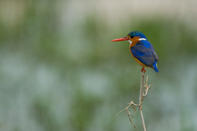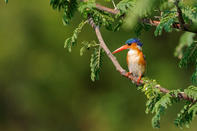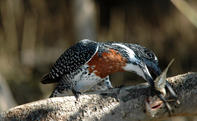To Stay or Leave
Whether kingfishers are piscivorous or insectivorous influences whether they migrate or not. Fish occur in a more or less constant supply all year round, while insects are most abundant in summer diminishing into the winter season. The insectivorous Pygmy Kingfisher is an intra-African migrant while the similarly sized Malachite, a fish-eater, is resident.

The bill of the kingfisher is straight and sharp an adaptation for catching fish, which is grabbed with the tip of the bill before being taken back to a perch where it is beaten and swallowed head first. Piscivores like the Malachite kingfisher swallow their fish food head first to avoid choking. Head first the fins, scales and tail align the correct way helping the fish simply slip down the kingfisher’s throat.
Kingfishers regurgitate pellets of indigestible material in the manner of owls. These pellets contain particles too large to pass from the stomach to the intestine through the pyloric valve. The pellets are much smaller than those produced by owls and crumble away quickly.
Syndactyl Feet

Kingfishers have syndactyl feet. This is where the second and third toes are fused but the reason for this is poorly understood and is a trait shared with only the hornbills.
Kingfishers have weak perching legs and seldom land on the ground as they do not have the power to ‘jump’ into flight again rapidly should danger threaten. This is particularly true when they are bathing and to compensate for this handicap (with the added weight of wet feathers), they rather plunge bathe from a perch.
No Colour Pigment

The bright blue of some of the kingfishers’ feathers is the result of tyndal scattering. This is where the layers of structural keratin that make up the feathers are interspersed with air spaces and reflect particular wavelengths of light to appear blue. There is no colour pigment in the feathers.
By Megan Emmet